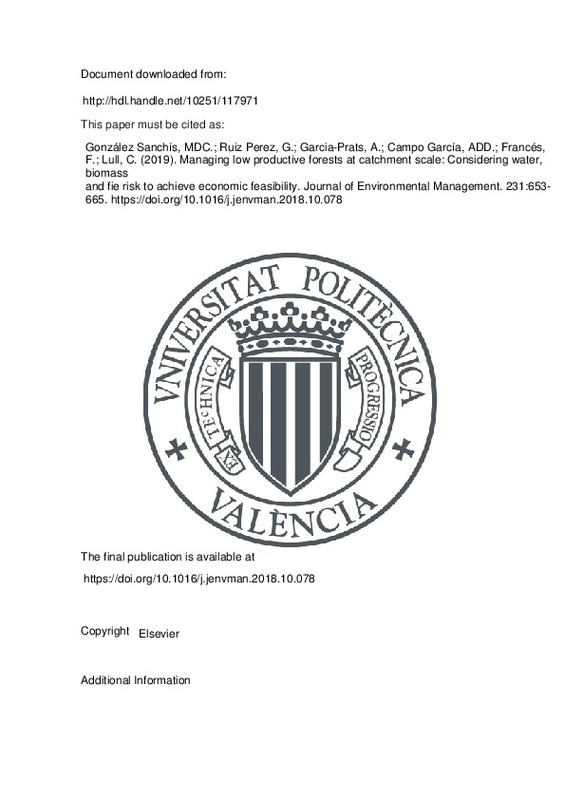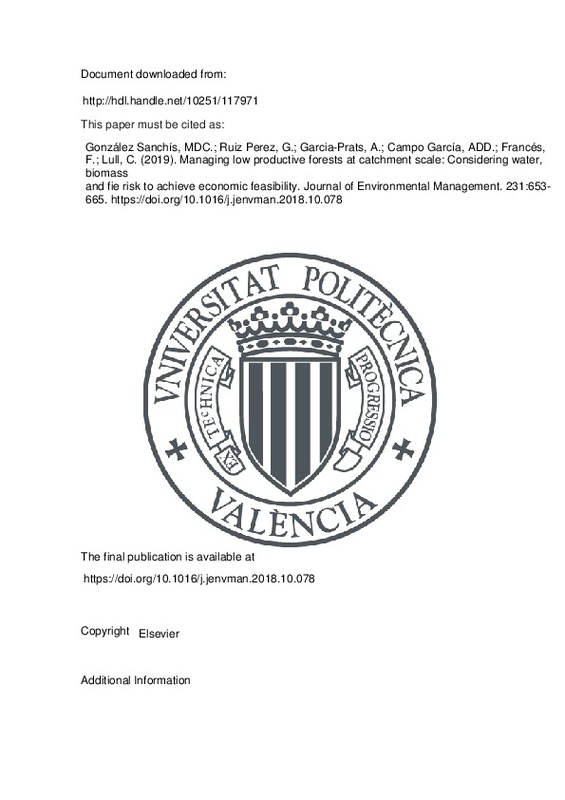JavaScript is disabled for your browser. Some features of this site may not work without it.
Buscar en RiuNet
Listar
Mi cuenta
Estadísticas
Ayuda RiuNet
Admin. UPV
Managing low productive forests at catchment scale: Considering water, biomass and fie risk to achieve economic feasibility
Mostrar el registro sencillo del ítem
Ficheros en el ítem
| dc.contributor.author | González Sanchís, María del Carmen
|
es_ES |
| dc.contributor.author | Ruiz Perez, Guiomar
|
es_ES |
| dc.contributor.author | Garcia-Prats, Alberto
|
es_ES |
| dc.contributor.author | Campo García, Antonio Dámaso Del
|
es_ES |
| dc.contributor.author | Francés, F.
|
es_ES |
| dc.contributor.author | Lull, Cristina
|
es_ES |
| dc.date.accessioned | 2019-03-11T21:00:19Z | |
| dc.date.available | 2019-03-11T21:00:19Z | |
| dc.date.issued | 2019 | es_ES |
| dc.identifier.issn | 0301-4797 | es_ES |
| dc.identifier.uri | http://hdl.handle.net/10251/117971 | |
| dc.description.abstract | [EN] Semi-arid forests are water limited environments considered as low-productive. As a result, these forests usually end up unmanaged and abandoned, with the subsequent wild fire risk increasing, water yield decreasing and a general diminishing of the forest resilience. Hydrological-oriented silviculture could be a useful alternative that increases management possibilities by combining forest productivity and water yield. However, the slight water yield increase after forest management together with the low forest productivity, could make this option insufficient for semi-arid forests, and other goods and services should be included and quantified. In this sense, the present study analyzes to what extent semi-arid forest management for water yield results effective and profitable at catchment scale, and how does it improve when it is combined with other benefits such as biomass production and fire risk diminishing. To that end, the effects of forest management of semi-arid Aleppo pine post-fire regeneration stands are analyzed in terms of water yield (TETIS-VEG model), fire risk (KDBY index and FARSITE) and biomass production, at catchment scale. Regarding to water yield, the results confirmed the slight effect of forest management on its increase (average increase of 0.27 +/- 0.29 mm yr(-1)), at the same time that highlighted the role of the upper catchment area as an important water contributor. The management produced 4161.6 Mg of biomass, and decreased in 27 +/- 17% and 25.6 +/- 14.1% the fire risk and fire propagation, respectively. Finally, a simple economic estimation of the management profitability is carried out by means of comparing the Benefit/Cost ratio of the managed and unmanaged scenarios. Both scenarios were always above the unity when just considering water as benefit, although the unmanaged scenario produced a higher ratio, as no management costs are expended. Contrarily, when wildfire was also included into the evaluation, the situation is overturned for wildfires equal or higher than 1.5 day duration, where the forest management is shown as the most convenient alternative. | es_ES |
| dc.description.sponsorship | This study is a component of the research projects: INTEGRA (CGL2011-28776-0O2), E-HIDROMED (CGL2014-58127-C3) and CEHYRFO-MED (CGL2017-86839-C3-2-R) funded by the Spanish Ministry of Science and Innovation and FEDER funds, and LIFE17 CCA/ES/000063 RESILIENTFORESTS. The authors are grateful to the Valencia Regional Government (CMAAUV, Generalitat Valenciana), the VAERSA staff, the Natural Park staff and the communal authority of Serra (specially Juanjo Mayans) for their support and allowing the use of the Natural Park experimental forest. | en_EN |
| dc.language | Inglés | es_ES |
| dc.publisher | Elsevier | es_ES |
| dc.relation.ispartof | Journal of Environmental Management | es_ES |
| dc.rights | Reconocimiento - No comercial - Sin obra derivada (by-nc-nd) | es_ES |
| dc.subject | Water scarcity | es_ES |
| dc.subject | Forest management | es_ES |
| dc.subject | Wild fire risk | es_ES |
| dc.subject | Hydrological modeling | es_ES |
| dc.subject | Profitability | es_ES |
| dc.subject | Forest ecosystem services | es_ES |
| dc.subject.classification | INGENIERIA HIDRAULICA | es_ES |
| dc.subject.classification | TECNOLOGIA DEL MEDIO AMBIENTE | es_ES |
| dc.subject.classification | EDAFOLOGIA Y QUIMICA AGRICOLA | es_ES |
| dc.title | Managing low productive forests at catchment scale: Considering water, biomass and fie risk to achieve economic feasibility | es_ES |
| dc.type | Artículo | es_ES |
| dc.identifier.doi | 10.1016/j.jenvman.2018.10.078 | es_ES |
| dc.relation.projectID | info:eu-repo/grantAgreement/MINECO//CGL2014-58127-C3-2-R/ES/DESARROLLO DE CONCEPTOS Y CRITERIOS PARA UNA GESTION FORESTAL DE BASE ECO-HIDROLOGICA COMO MEDIDA DE ADAPTACION AL CAMBIO GLOBAL (SILWAMED)/ | es_ES |
| dc.relation.projectID | info:eu-repo/grantAgreement/EC//LIFE17 CCA%2FES%2F000063/EU/Coupling water, fire and climate resilience with biomass production in Forestry to adapt watersheds to climate change/LIFE RESILIENT FORESTS/ | es_ES |
| dc.relation.projectID | info:eu-repo/grantAgreement/AEI/Plan Estatal de Investigación Científica y Técnica y de Innovación 2013-2016/CGL2017-86839-C3-2-R/ES/INCORPORACION DE CRITERIOS ECO-HIDROLOGICOS Y DE RESILIENCIA FRENTE A PERTURBACIONES CLIMATICAS Y DEL FUEGO EN LA PLANIFICACION Y GESTION FORESTAL DE CUENCAS MEDITERRANEAS/ | es_ES |
| dc.relation.projectID | info:eu-repo/grantAgreement//LIFE17 CCA/ES/000063/ | es_ES |
| dc.relation.projectID | info:eu-repo/grantAgreement/MICINN//CGL2011-28776-C02-02/ES/CARACTERIZACION HIDROLOGICA DE LA ESTRUCTURA FORESTAL A ESCALA PARCELA PARA LA IMPLEMENTACION DE SILVICULTURA ADAPTATIVA/ | es_ES |
| dc.rights.accessRights | Abierto | es_ES |
| dc.contributor.affiliation | Universitat Politècnica de València. Departamento de Ingeniería Hidráulica y Medio Ambiente - Departament d'Enginyeria Hidràulica i Medi Ambient | es_ES |
| dc.contributor.affiliation | Universitat Politècnica de València. Departamento de Química - Departament de Química | es_ES |
| dc.description.bibliographicCitation | González Sanchís, MDC.; Ruiz Perez, G.; Garcia-Prats, A.; Campo García, ADD.; Francés, F.; Lull, C. (2019). Managing low productive forests at catchment scale: Considering water, biomass and fie risk to achieve economic feasibility. Journal of Environmental Management. 231:653-665. https://doi.org/10.1016/j.jenvman.2018.10.078 | es_ES |
| dc.description.accrualMethod | S | es_ES |
| dc.relation.publisherversion | https://doi.org/10.1016/j.jenvman.2018.10.078 | es_ES |
| dc.description.upvformatpinicio | 653 | es_ES |
| dc.description.upvformatpfin | 665 | es_ES |
| dc.type.version | info:eu-repo/semantics/publishedVersion | es_ES |
| dc.description.volume | 231 | es_ES |
| dc.relation.pasarela | S\371573 | es_ES |
| dc.contributor.funder | Agencia Estatal de Investigación | es_ES |
| dc.contributor.funder | Ministerio de Economía y Competitividad | es_ES |
| dc.contributor.funder | European Commission | es_ES |
| dc.contributor.funder | Ministerio de Ciencia e Innovación | es_ES |








![[Cerrado]](/themes/UPV/images/candado.png)

